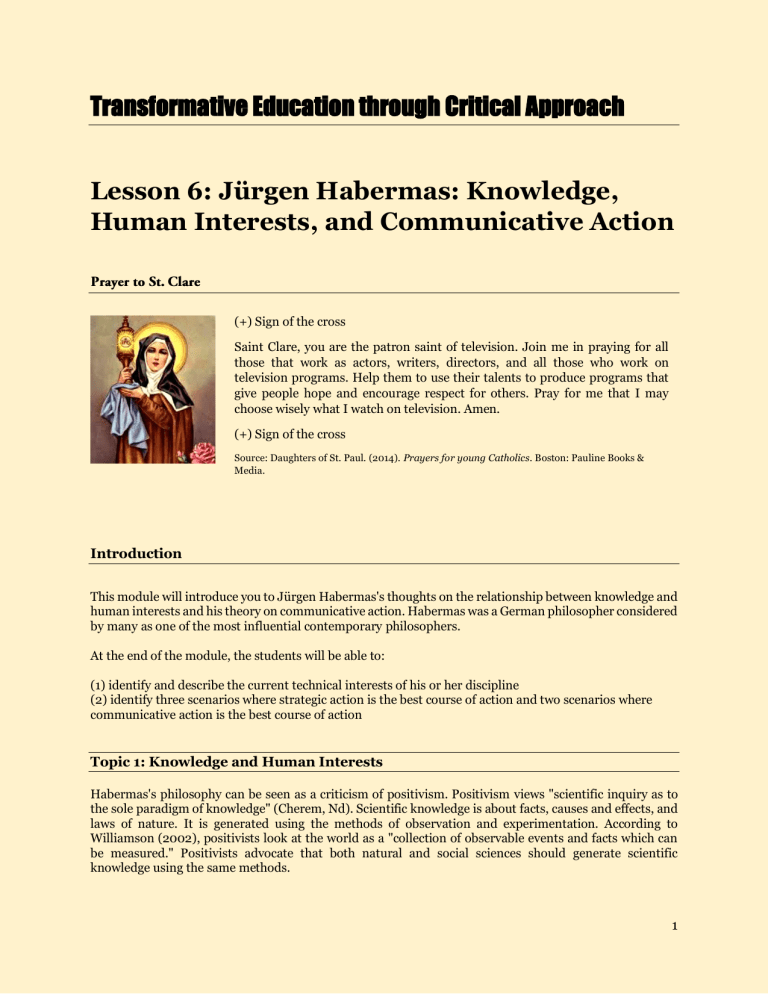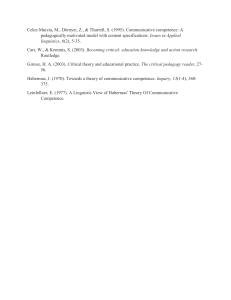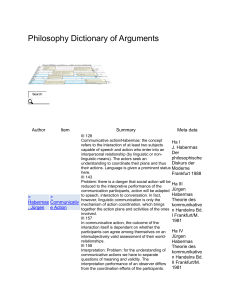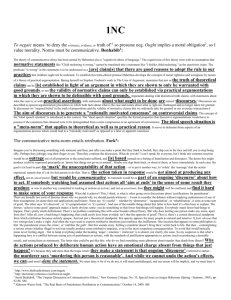Jurgen Habermas Knowledge, Human Interests and Communication - TRANSFO
advertisement

Transformative Education through Critical Approach Lesson 6: Jürgen Habermas: Knowledge, Human Interests, and Communicative Action (+) Sign of the cross Saint Clare, you are the patron saint of television. Join me in praying for all those that work as actors, writers, directors, and all those who work on television programs. Help them to use their talents to produce programs that give people hope and encourage respect for others. Pray for me that I may choose wisely what I watch on television. Amen. (+) Sign of the cross Source: Daughters of St. Paul. (2014). Prayers for young Catholics. Boston: Pauline Books & Media. Introduction This module will introduce you to Jürgen Habermas's thoughts on the relationship between knowledge and human interests and his theory on communicative action. Habermas was a German philosopher considered by many as one of the most influential contemporary philosophers. At the end of the module, the students will be able to: (1) identify and describe the current technical interests of his or her discipline (2) identify three scenarios where strategic action is the best course of action and two scenarios where communicative action is the best course of action Topic 1: Knowledge and Human Interests Habermas's philosophy can be seen as a criticism of positivism. Positivism views "scientific inquiry as to the sole paradigm of knowledge" (Cherem, Nd). Scientific knowledge is about facts, causes and effects, and laws of nature. It is generated using the methods of observation and experimentation. According to Williamson (2002), positivists look at the world as a "collection of observable events and facts which can be measured." Positivists advocate that both natural and social sciences should generate scientific knowledge using the same methods. 1 According to Habermas, the positivistic view consists of three claims: (a) scientific knowledge is knowledge of cause and effects that can be used as an explanation (b) scientific knowledge is knowledge of facts about nature (c) scientific knowledge is about what is/exists, not about what should be (Cherem, N.d.) Knowledge can be used as a tool to advance social goals. In scientific knowledge, it can be utilized to control nature and produce materials needed for human survival. Habermas says that knowledge of scientific and social progress is guided by three types of "knowledge constitutive interests"—technical, practical, and emancipatory (Cherem, N.d.). Human interests drive the pursuit of knowledge. 1. Technical interest. This human interest to generate knowledge that can be used to predict and control the natural environment. Meteorological knowledge is required to predict the behavior of weather systems. Understanding the nature of the SARS Cov-2 virus enables scientists to develop health management protocols to control infection in the population and treat patients. Hydrologists study water systems (e.g., rivers, lakes, creeks) and use the knowledge they gain to build dams and harness water's energy to power communities. The ability to control nature is necessary for the survival of the human species. It is produced through observation and experimentation, that is, testing of hypothesis. Technical interest is connected with labor. Labor involves the production of materials needed by the human species. The smartphone or computer you are using to read this sentence is the consequence of pursuing a technical interest. According to Cherem (N.d.), "humans use tools and technologies to manage nature for material accommodation." 2. Practical interest. This human interest to generate knowledge aims to "secure and expand possibilities of mutual and self-understanding in the conduct of life" (Bohman & Rehg, 2014). Controlling nature is not the only thing necessary for the survival of humankind. We also need to understand each other to avoid conflicts. Understanding is a requirement for social coordination so that we can work together to pursue our interests. Understanding depends on our competencies to interpret the meaning of utterances. And language acts as a medium for coordinating our actions (Bohman & Rehg, 2014). According to Cherem (N.d.), practical interest is in the social reproduction of human communities through intersubjective norms of culture and communication. Human social life requires members who can understand each other, share expectations, and achieve cooperation. The knowledge that emerges from technical and practical interest is kept and disseminated through social institutions, such as family, schools, churches, state, etc. 3. Emancipatory interest in freedom and autonomy. For Habermas, the labor of material reproduction (technical interest) and the interaction norms of social reproduction (practical interest) require, in a weak sense, psychosocial mechanisms to repress or deny basic drives and impulses that would destroy material and social reproduction. For instance, labor requires delayed gratification (meaning, work first before receiving compensation), and social interaction requires internalized notions of obligation, reciprocity, shame, guilt, and so forth (for example, making a promise requires sincerity and obligation to fulfill what one promises). Psychosocial mechanisms of control are often used far more than they need to secure material and social reproduction. Those in power may find psychosocial mechanisms useful. If women are falsely taught, there are natural laws of gender relations such that the dominant patterns of marriage and domestic work that consistently disadvantage them are the best they can hope for; this is an ideological mechanism of social control (Cherem, N.d.) Habermas posits a human interest in using self-reflection and insight to combat ideologically veiled, superfluous social domination to realize freedom and autonomy. It is the limitation of freedom and 2 autonomy for no purpose other than domination, and it "functions" through systematically distorted communication. He calls for the exercise of critical reflection on self and society to unveil and dissolve internalized oppressive power structures that betray one's real interests. Topic 2: Theory of Communication Action* Habermas characterizes human society as a system that integrates material production (work) and normative socialization (interaction) processes through linguistically coordinated action. Habermas made a distinction between two modes of action: work and interaction. These modes point to the "enduring interests of the human species" (Bohman & Rehg, 2014). Work is a mode of action based on the "rational choice of efficient means," a form of instrumental and strategic action. Interaction is a form of communication action where the "actors coordinate their behaviors based on the consensual norm. Labor is an action type that aims at technical control to achieve success. Interaction is an action type that aims at mutual understanding embodied in consensual norms. To better understand communicative action, we need to examine first strategic action to compare it with communicative action. In strategic action, actors are not so much interested in mutual understanding as in achieving the individual goals they each bring to the situation. Actor A, for example, will thus appeal to B's desires and fears so as to motivate the behavior on B's part that is required for A's success. As reasons motivating B's cooperation, B's desires and fears are only contingently related to A's goals. B cooperates with A, in other words, not because B finds A's project inherently interesting or worthy, but because of what B gets out of the bargain: avoiding some threat that A can make or obtaining something A has promised (which may be of inherent interest to B but for A is only a means of motivating B). In communicative action, speakers coordinate their actions and pursue individual (or joint) goals based on a shared understanding that the goals are inherently reasonable or merit-worthy. Whereas strategic action succeeds insofar as the actors achieve their individual goals, communicative action succeeds insofar as the actors freely agree that their goal (or goals) is reasonable and merits cooperative behavior. Thus, communicative action is an inherently consensual form of social coordination in which actors "mobilize the potential for rationality" given with ordinary language and its telos of rationally motivated agreement. Communicative action can be seen as a practical attitude or way of engaging others that are highly consensual, and that fully embodies the inbuilt aim of speech: reaching a mutual understanding. Habermas distinguishes weak and strong communicative action. The weak form is an exchange of reasons aimed at mutual understanding. The strong form is a practical attitude of engagement seeking fairly robust cooperation based on a consensus about a shared enterprise's substantive content. This allows solidarity to flourish. In either form, communicative action is distinct from "strategic action," wherein socially interacting people aim to realize their own individual goals by using others like tools or instruments (indeed, he calls this type of action "instrumental" when it is solitary or non-social). A key difference between strategic and communicative action is that strategic actors have a fixed, nonnegotiable objective in mind when entering the dialogue. The point of their engagement is to appeal, induce, cajole, or compel others into complying with what they think it takes to bring their objective about. In contrast, communicatively acting parties seek a mutual understanding that can serve as the basis for cooperation. In principle, this involves openness to an altered understanding of one's interests and aims in the face of better reasons and arguments. Another contrast between communicative and strategic action mainly concerns how an action is pursued. Indeed, while these action orientations are mutually exclusive when seen from an actor's perspective, the 3 same goal can often be approached in either communicative or strategic ways. Strategic action is about eliciting, inducing, or compelling others' behavior to realize one's individual goals. This differs from communicative action, rooted in the give-and-take of reasons and the "unforced force" of the best argument justifying an action norm. References Bohman, J., and Rehg, W. (2014). Jürgen Habermas. Retrieved from Stanford Encyclopedia of Philosophy https://plato.stanford.edu/entries/habermas/ Cherem, M. (N.d.). Jürgen Habermas. Retrieved from Internet Encyclopedia of Philosophy, https://iep.utm.edu/habermas/ Williamson, K. et al. (2002). Research Methods for Students, Academics and Professionals (2nd Ed.). Chandos Publishing. 4



